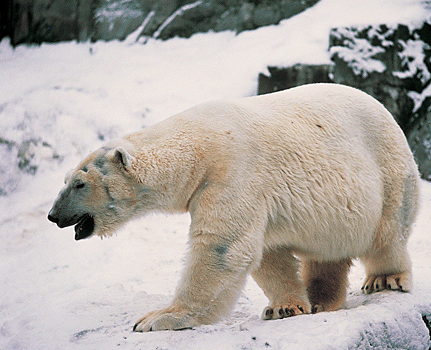Scientists Trace Polar Bears’ Ancient History
Friday, April 20th, 2012Polar bears are more distantly related to other bears than previously thought, according to new research. Scientists have long known that polar bears share a common ancestor with brown bears. Previous research had shown that the split between the two groups occurred relatively recently, about 150,000 years ago. But in new research, scientists found that the split took place much earlier, about 600,000 years ago. Thus, polar bears are more distinct from other bears than scientists thought.
The research helps scientists to understand the history of how polar bears have evolved (developed over many generations). Polar bears have many adaptations (features) that help them to survive on Arctic sea ice. These adaptations help to make them different from brown bears. Polar bears would have had to evolve these adaptations in relatively little time if they had split from the same ancestor as brown bears only 150,000 years ago.
The new research involved studying bear DNA, which carries hereditary information. Scientists compared the DNA of black bears, brown bears, and polar bears. Comparing the DNA enabled scientists to estimate the date at which polar bears and brown bears shared a common ancestor. Earlier research into polar bear origins used DNA from a different part of the cell. Most DNA is housed in the cell’s nucleus (a body at the center of the cell). However, a small amount of DNA is housed in mitochondria (tiny bodies in the cell that burn chemical energy). The earlier research used DNA from the mitochondria to estimate the first appearance of polar bears. The new research used DNA from the nucleus. This information provided more data about polar bear origins.

The hardy polar bear lives along the frozen shores and in the icy waters of the Arctic Ocean. Polar bears have a thick, white coat that blends in with the ice and snow. They swim strongly by paddling with their front legs and stretching their head forward. (Marvin E. Newman, DPI)
Scientists suggest the different estimates for the first appearance of polar bears may have been caused by later matings between polar bears and brown bears. Such mating is known to occur, especially when polar bear populations are under stress. Thus, the mitochondria results may record breeding between polar bears and brown bears about 150,000 years ago. In fact, the research suggested that polar bears have gone through several so-called bottlenecks, periods during which relatively few polar bears survived. These bottlenecks may have corresponded to reduced sea ice or other climate changes that made it more difficult for polar bears to survive. Polar bears are currently considered vulnerable to extinction because of a loss of sea ice caused by climate change, and scientists have shown that some polar bears and brown bears have breed in recent years. The research was published online in the journal Science.
Additional World Book articles:
The Great Meltdown (a special report)


